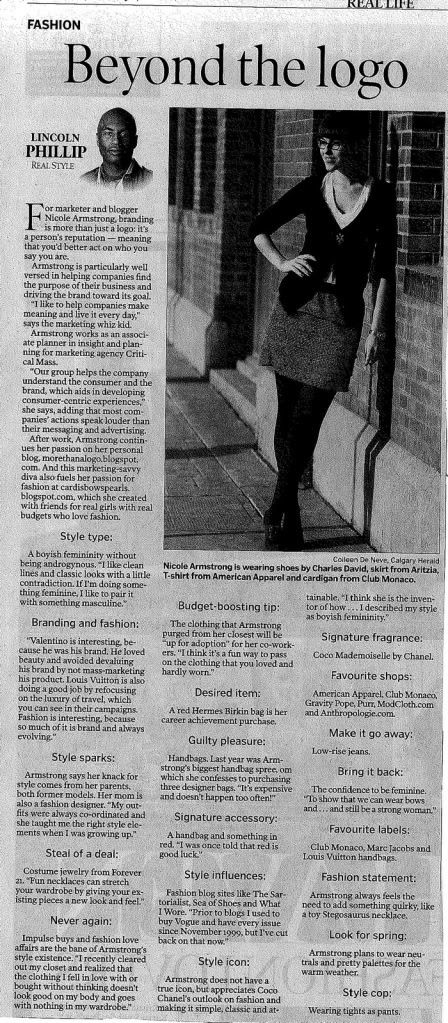
For marketer and blogger Nicole Armstrong, branding is more than just a logo: it's a person's reputation - meaning that you'd better act on who you say you are.
Armstrong is particularly well versed in helping companies find the purpose of their business and driving the brand toward its goal.
"I like to help companies make meaning and live it every day," says the marketing whiz kid.
Armstrong works as an associate planner in insight & planning for marketing agency Critical Mass.
"Our group helps the company understand the consumer and the brand, which aids in developing consumer-centric experiences," she says, adding that most companies' actions speak louder that their messaging and advertising.
After work, Armstrong continues her passion on her personal blog, morethanalogo.blogspot.com. And this marketing-savvy diva also fuels her passion for fashion at cardisbowspearls.blogspot.com, which she created with friends for real girls with real budgets who love fashion.
Style Type:
A boyish femininity without being androgynous. "I like clean lines and classic looks with a little contradiction. If I'm doing something feminine, I like to pair it with something masculine."
Branding and Fashion:
"Valentino is interesting, becuase he was his brand. He loved beauty and avoided devaluing his brand by not mass-marketing her product. Louis Vuitton is also doing a good job by refocusing on the luxury of travel, which you can see in their campaigns. Fashion is interesting, because so much of it is brand and always evolving."
Style Sparks:
Armstrong says her knack for style comes from her parents, both former models. Her mom is also a fashion designer. "My outfits were always co-ordinated and she taught me the right style elements when I was growing up."
Steal of a Deal:
Costume jewelry from Forever 21. "Fun necklaces can stretch your wardrobe by giving your existing pieces a new look and feel."
Never Again:
Impulse buys and fashion love affairs are the bane of Armstrong's style existence. "I recently cleared out my and realized that the clothing I fell in love with or bought without thinking doesn't look good on my body and goes with nothing in my wardrobe."
Budget-Boosting Tip:
The clothing that Armstrong purged from her closet will be "up for adoption" for her co-workers. "I think it's a fun way to pass on the clothing that you loved and hardly worn."
Desired Item:
A red Hermes Birkin bag is her career achievement purchase.
Guilty Pleasure:
Handbags. Last year was Armstrong's biggest hangbag handbag spree, on which she confesses to purchasing three designer bags. "It's expensive and doesn't happen too often!"
Signature Accessory:
A handbag and something in red. "I was once told that red is good luck."
Style Influences:
Fashion blog sites like The Sartorialist, Sea of Shoes and What I Wore. "Prior to blogs I used to buy Vogue and have every issue since November 1999, but I've cut back on that now."
Style Icon:
Armstrong does not have a true icon, but appreciates Coco Chanel's outlook on fashion and making it simple, classic and attainable. "I think she is the inventor of how...I described my style as boyish femininity."
Signature Fragrance:
Coco Mademoiselle by Chanel
Favorite Shops:
American Apparel, Club Monaco, Gravity Pope, Purr, ModCloth.com and Anthropologie.com.
Make it Go Away:
Low-rise jeans.
Bring it Back:
The confidence to be feminine. "To show that we can wear bows and...and still be a strong woman."
Favoite Labels:
Club Monaco, Marc Jacobs & Louis Vuitton handbags.
Fashion Statement:
Armstrong always feels the need to add something quirky, like a toy Stegosaurus necklace.
Look for Spring:
Armstrong plans to wear neutrals and pretty palettes for the warm weather.
Style Cop:
Wearing tights as pants.
 First is Saffron's European City Brand Barometer report by Jeremy Hildreth. I really enjoyed reading this report for its discussion on the cities' brand strength paired with how well it is leveraging it's brand assets. Location branding is something that interests me, as it proves that branding & brand strategy are not just for organizations!
First is Saffron's European City Brand Barometer report by Jeremy Hildreth. I really enjoyed reading this report for its discussion on the cities' brand strength paired with how well it is leveraging it's brand assets. Location branding is something that interests me, as it proves that branding & brand strategy are not just for organizations! 



















